You may be required to provide trained interpreters for non-English speaking patients. Dental offices that are subject to regulation under Section 1557 of the Affordable Care Act, as well as certain instances under the Americans with Disabilities Act, may prompt a dentist to look for translation services.
Even if you are not required to do so, you may find that you need assistance in communicating fully with your patient. According to Edgardo Garcia, translation services director for the Children’s Medical Center Dallas, using trained interpreters results in more accurate diagnoses and better patient compliance. In addition, remember that taking time to prepare for an appointment that requires an interpreter makes everything run a little more smoothly, and can even help save you a little money, as the appointment should go more efficiently.
Top 7 tips for working effectively with an interpreter:
-
Provide the interpreter with a brief explanation of what you need to achieve during the conversation with your non-English proficient patient.
- If you are with your patient, speak directly to them and make eye contact while you speak even though you’re waiting for the interpreter to interpret.
- Use short but complete phrases. Remember, the interpreter needs to process two languages.
- Speak in the first person.
- Avoid slang, jargon or metaphors.
- Allow the interpreter to clarify linguistic and cultural issues.
Be patient. It may take some time, but the clear communication you are able to achieve will be worth it.
Curious about what language potential patients in your state may need? Find out the top ten languages used in your state.
This information was provided courtesy of CyraCom Interpretation services. CyraCom, whose interpreters complete 120-hour certification courses and specialize in healthcare interpreting, including a focus on dental terms, is endorsed by ADA Member Advantage. You can view more information here or by calling 844.737.0781.
